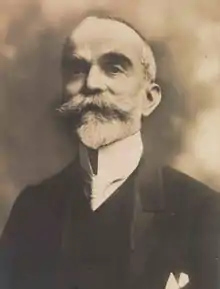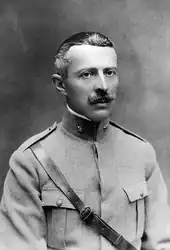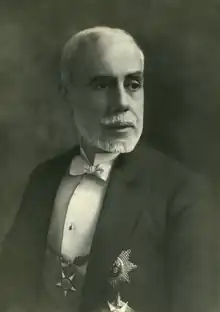First Portuguese Republic
The First Portuguese Republic (Portuguese: Primeira República Portuguesa; officially: República Portuguesa, Portuguese Republic) spans a complex 16-year period in the history of Portugal, between the end of the period of constitutional monarchy marked by the 5 October 1910 revolution and the 28 May 1926 coup d'état. The latter movement instituted a military dictatorship known as Ditadura Nacional (national dictatorship) that would be followed by the corporatist Estado Novo (new state) regime of António de Oliveira Salazar.
Portuguese Republic | |||||||||
|---|---|---|---|---|---|---|---|---|---|
| 1910–1926 | |||||||||
 Coat of arms
| |||||||||
| Motto: Ordem e Trabalho ("Order and Work") | |||||||||
| Anthem: A Portuguesa ("The Portuguese") | |||||||||
.svg.png.webp) The Portuguese Republic in 1914 | |||||||||
| Capital | Lisbon | ||||||||
| Common languages | Portuguese[1] | ||||||||
| Demonym(s) | Portuguese | ||||||||
| Government | Unitary parliamentary republic | ||||||||
| President | |||||||||
• 1911–1915 (first) | Manuel de Arriaga | ||||||||
• 1925–1926 (last) | Bernardino Machado | ||||||||
| Prime Minister | |||||||||
• 1911 (first) | João Pinheiro Chagas | ||||||||
• 1925–1926 (last) | António Maria da Silva | ||||||||
| Legislature | Congress of the Republic | ||||||||
• Upper house | Senate | ||||||||
• Lower house | Chamber of Deputies | ||||||||
| Historical era | World War I, Interwar | ||||||||
| 5 October 1910 | |||||||||
| 21 August 1911 | |||||||||
| 29 May 1926 | |||||||||
| Currency | Portuguese real (1910–1911) Portuguese escudo (1911–1926) | ||||||||
| |||||||||
| History of Portugal |
|---|
 |
| Timeline |
|
|
The sixteen years of the First Republic saw nine presidents and 44 ministries, and were altogether more of a transition between the Kingdom of Portugal and the Estado Novo than they were a coherent period of governance.
Religion
The First Republic was intensely anti-clerical. Historian Stanley Payne points out, "The majority of Republicans took the position that Catholicism was the number one enemy of individualist middle-class radicalism and must be completely broken as a source of influence in Portugal."[2] Under the leadership of Afonso Costa, the Minister of Justice, the revolution immediately targeted the Catholic Church; the provisional government began devoting its entire attention to an anti-religious policy, in spite of the disastrous economic situation. On 8th October the religious orders in Portugal were expelled, and their property was confiscated.[3] On 10 October – five days after the inauguration of the Republic – the new government decreed that all convents, monasteries and religious orders were to be suppressed. All residents of religious institutions were expelled and their goods were confiscated. The Jesuits were forced to forfeit their Portuguese citizenship. A series of anti-Catholic laws and decrees followed each other in rapid succession. On 3 November, a law legalizing divorce was passed and then there were laws to recognize the legitimacy of children born outside wedlock, authorize cremation, secularize cemeteries, suppress religious teaching in the schools and prohibit the wearing of the cassock. In addition, the ringing of church bells to signal times of worship was subjected to certain restraints, and the public celebration of religious feasts was suppressed. The government also interfered in the running of seminaries, reserving the right to appoint professors and determine curricula. This whole series of laws authored by Afonso Costa culminated in the law of Separation of Church and State, which was passed on 20 April 1911.
The republicans were anticlerical and had a "hostile" approach to the issue of church and state separation, like that of the French Revolution, and the future Mexican Constitution of 1917 and the Spanish Constitution of 1931.[4] On 24 May 1911, Pope Pius X issued the encyclical Iamdudum which condemned the anticlericalism of the new republic for its deprivation of religious civil liberties and the "incredible series of excesses and crimes which has been enacted in Portugal for the oppression of the Church."[5]
The Republic repelled a royalist attack on Chaves in 1912.
Heads of state and government
The First Portuguese Republic was an unstable period in the History of Portugal. In a period of 16 years (1910–1926) Portugal had 8 Presidents of the Republic, 1 Provisional Government, 38 Prime Ministers and 1 Constitutional Junta:
_-_Ringelke.png.webp) Manuel de Arriaga
Manuel de Arriaga
(1911–1915).png.webp) Teófilo Braga
Teófilo Braga
(1915) Bernardino Machado
Bernardino Machado
(1915–1917; 1925–1926) Sidónio Pais
Sidónio Pais
(1918) João do Canto e Castro
João do Canto e Castro
(1918–1919) António José de Almeida
António José de Almeida
(1919–1923) Manuel Teixeira Gomes
Manuel Teixeira Gomes
(1923–1925)
Evaluation of the republican experiment and legacy
Most historians have emphasized the failure and collapse of the republican dream by the 1920s. José Miguel Sardica in 2011 summarized the consensus of historians:
.jpg.webp)
"[…] within a few years, large parts of the key economic forces, intellectuals, opinion-makers and middle classes changed from left to right, trading the unfulfilled utopia of a developing and civic republicanism for notions of "order," "stability" and "security." For many who had helped, supported or simply cheered the Republic in 1910, hoping that the new political situation would repair the monarchy’s flaws (government instability, financial crisis, economic backwardness and civic anomie), the conclusion to be drawn, in the 1920s, was that the remedy for national maladies called for much more than the simple removal of the king […] The First Republic collapsed and died as a result of the confrontation between raised hopes and meager deeds."[6]
Sardica, however, also points up the lasting effects of the republican experiment:
"Despite its overall failure, the First Republic endowed twentieth-century Portugal with an insurpassable and enduring legacy—a renewed civil law, the basis for an educational revolution, the principle of separation between State and Church, the overseas empire (only brought to an end in 1975), and a strong symbolic culture whose materializations (the national flag, the national anthem and the naming of streets) still define the present-day collective identity of the Portuguese. The Republic’s prime legacy was indeed that of memory."[7]
References
- (in Continental Portugal, Madeira and Azores, official in the Portuguese Empire)
- Payne, A history of Spain and Portugal (1973) 2: 559
- "Portugal - The First Republic, 1910–26". Encyclopedia Britannica. Retrieved 2021-07-16.
- Maier, Hans (2004). Totalitarianism and Political Religions. trans. Jodi Bruhn. Routledge. p. 106. ISBN 0-7146-8529-1.
- IAMDUDUM: ON THE LAW OF SEPARATION IN PORTUGAL Papal Encyclicals Online
- E-Journal of Portuguese History. (2011). 9 (1): pp. 1–27.
- José Miguel Sardica. The Memory of the Portuguese First Republic throughout the Twentieth Century. (2011).
Further reading
- Leal, Ernesto Castro. "Parties and political identity: the construction of the party system of the Portuguese Republic (1910–1926)." E-journal of Portuguese History 7#1 (2009): 37–44. Online
- Meneses, Filipe Ribeiro De. Afonso Costa (London: Haus Publishing, 2010); 227 pp. excerpt
- Sardica, José Miguel. "The Memory of the Portuguese First Republic throughout the Twentieth Century," E-Journal of Portuguese History (Summer 2011) 9#1: 1–27. online
- Wheeler, Douglas L. "The Portuguese revolution of 1910." Journal of Modern History (1972): 172–194. in JSTOR
- Wheeler, Douglas L. Republican Portugal: a political history, 1910–1926 (U of Wisconsin Press, 1999)

